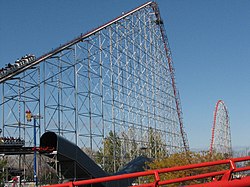Magnum XL-200
| Magnum XL-200 | |
|---|---|
 |
|
| Cedar Point | |
| Coordinates | 41°29′7.25″N 82°41′10″W / 41.4853472°N 82.68611°WCoordinates: 41°29′7.25″N 82°41′10″W / 41.4853472°N 82.68611°W |
| Status | Operating |
| Opening date | May 6, 1989 |
| Cost | US$ 8,000,000 |
| General statistics | |
| Type | Steel |
| Manufacturer | Arrow Dynamics |
| Designer | Ron Toomer |
| Model | Hyper Coaster |
| Track layout | Out and Back |
| Lift/launch system | Chain lift hill |
| Height | 205 ft (62 m) |
| Drop | 194.7 ft (59.3 m) |
| Length | 5,106 ft (1,556 m) |
| Speed | 72 mph (116 km/h) |
| Inversions | 0 |
| Duration | 2:00 |
| Max vertical angle | 60° |
| Capacity | 2,000 riders per hour |
| Height restriction | 48 in (122 cm) |
| Trains | 3 trains with 6 cars. Riders are arranged 2 across in 3 rows for a total of 36 riders per train. |
|
|
|
|
Magnum XL-200 at RCDB Pictures of Magnum XL-200 at RCDB |
|
Magnum XL-200, colloquially known as simply Magnum, is a steel roller coaster built by Arrow Dynamics at Cedar Point in Sandusky, Ohio. When built in 1989, it was the tallest, fastest, and steepest complete-circuit roller coaster in the world as well as the first hypercoaster – a roller coaster that exceeds 200 feet (61 m) in height. Some have credited Magnum with starting a period in the industry known as the roller coaster wars, in which amusement parks competed with one another at a rapid pace to build the next tallest and fastest roller coaster. More than 40 million people had ridden Magnum as of 2009.
Magnum XL-200 held the title of tallest roller coaster in the world until 1994 when Pepsi Max Big One opened at Blackpool Pleasure Beach in the United Kingdom. Amusement Today presented Magnum with its "Best Steel Roller Coaster" Golden Ticket Award for three consecutive years in a row from 1998 to 2000. As of 2014[update], it was ranked thirteenth in the world by the same publication.
By the mid-1980s, Cedar Point had grown into a successful collection of roller coasters and other smaller rides on the shores of Lake Erie. Dick Kinzel took over as president and CEO of Cedar Fair, the company that operates the park, in 1986. In 1988, Kinzel saw a report on CNN about the opening of a new coaster in Japan called Bandit at Yomiuriland that emphasized height and speed but had no inversions. Kinzel wanted to introduce a similar coaster that emphasized steep drops and negative g-forces over inversions and spins, which were common at the time. It had been 10 years since the last major addition, Gemini, was introduced. Cedar Point asked for proposals from TOGO, Dinn Corporation, Intamin and Arrow Dynamics to build a roller coaster without inversions or over-the-shoulder restraints. They chose Arrow, which proposed a 187 feet (57 m)-tall coaster. That got Cedar Point's management interested in breaking the 200-foot (61 m) barrier, partly because of the publicity to be gained from building the first roller coaster to do so. The name Magnum XL-200 was chosen because Magnum, P.I. was popular at the time and Cedar Point's management wanted to incorporate the height into the name. The original proposal was to cost $7.5 million, but was raised to $8 million after the height was extended to 200 feet (61 m).
...
Wikipedia
